Official Name
Русе (Ruse, also: Rousse, sometimes also 'Russe'). Note that the 'u' is a rather long vowel. During the Ottoman rule, the town was known as Rustshuk.
Location
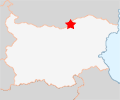
| ||
| Ruse |
Ruse stretches along the south shore of the Danube river, which marks the border between Bulgaria and →Romania. To the capital of Romania, →Bucharest, it's only around 80 km. To →Sofia it's around 280 km to the south-west. Ruse is located in the Danube plain, but the mountains in the south are not very far.
Population
Around 184,000
Orientation
The town is home to Bulgaria's largest Danube port - especially north of Ruse, there's a lot of industry and harbour facilities. The centre of town around Пл. Свобода (Pl. Svaboda, Liberty square) is rather small and easy to orientate. There aren't any extraordinarely tall buildings, but a lot of Habsburg-style buildings and a concrete monstrosity called city hall. Obviously, there was a construction boom after gaining independence from the Ottomans at the end of the 19th century. The city council ordered, that every new building shall have a balcony and a richly decorated façade. Quite a progressive decision! The Danube river is only around 300 metres away from Liberty square. Walking along Борисова (Borisova st.) from the centre to the south brings you to the old and beautiful train station (which was under reconstruction in 2003). Adjacent to the train station, on the left side, is the bus terminal. From there, buses run to all bigger cities in Bulgaria and to some destinations abroad. The river promenade is an excellent place for a stroll along the Danube. However, don't expect something like a nice beach or so.
History
Ancient Romans built a first fortress near present-day Ruse in the year 70 AD and named it Sexaginta Prista. However, this fortress was abandoned during the 6th century. As a replacement, a new town called Cherven was built some kilometres south of Ruse. But after the occupation by the Ottomans, this town was abandoned as well. The Ottomans themselves started to construct a new town and called it Rustshuk - this town was built on the remainings of Sexaginta Prista. In 1866, the Ottomans connected Ruse with Varna by railway.
Getting there / transportation
International trains from →Prague to →Varna (only in summer!) and from →Bucharest to →Sofia stop in Ruse. Six trains a day cross the border to Romania - three of them are local trains, which only run to Giurgiu on the northern bank of the Danube. Several buses and trains run to →Sofia, but be aware that the train needs a few hours more than the bus to the capital. By bus, it takes around 4 ½ hours, the fare is 10 Leva (€ 5). Of course, there are many other buses, running to →Varna, →Veliko Tarnovo and so on.
There aren't any real gems in Ruse, but it's the pleasant atmosphere in the city centre that makes the place a worthwile destination for a day or two. The absolute centre of town is the above-mentioned Liberty square, from where 18 (!) streets start in every direction. In the middle of the square, there's the Monument to Liberty (what else). Most of the square is green and surrounded by countless cafés and restaurants. One of the streets starting from Liberty square is the Александровска (Alexandrovska), which is the main shopping streets of Ruse. Some of the buildings lining up along Alexandrovska are quite remarkable. Furthermore, there are some museums to visit in Ruse. Below some images from Ruse:
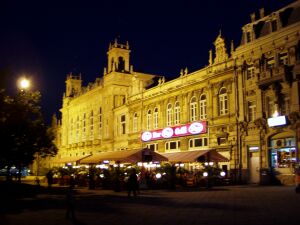
| ||
| Liberty square at night |
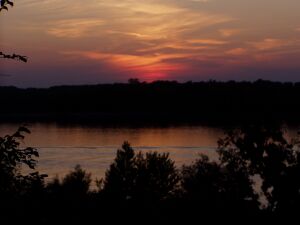
| ||
| Sundown at the river Danube (the other shore side is Romania) |
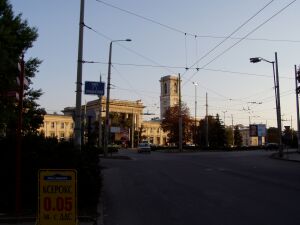
| ||
| The old train station of Ruse |
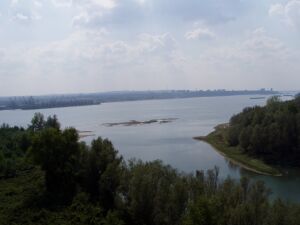
| ||
| A view from the bridge to the Danube and Ruse |
Around 6 km north of the city centre of Ruse to the north, there's the so-called Friendship Bridge, which is the longest steel girder bridge of Europe. The bridge is 2.8 km long and consists of two levels - the lower level is for trains, the upper level for cars. It was built in 1954 and reconstructed in 2003 with the help of EU funds. The name is quite funny, since Bulgarians do not really like the Romanians - and probably vice versa. And Bulgarians don't really like the Turks. And so on. The bridge marks one of the most important border crossings between the two countries. After crossing the bridge from Bulgaria, you won't see much - the city centre of the Romanian town Giurgiu (pronounced jur-jou) is around 4.5 km away from the crossing. However, Giurgiu is definitely no must-see place. There are regular buses running from the centre of Ruse to the crossing (0.4 Leva) but no public transport from the crossing to the centre of Giurgiu.
Not many travelers find their way to Ruse (and stay overnight), so there aren't many hotels. But Dunav Tours (ploshtad Khan Kubrat 5, Tel.: 223088 - three minutes away on foot from Liberty Square) offers private rooms in the city centre. A double right in the middle of town set us back € 16. 10% are to be paid in the office, the rest is to be paid to the owner of the private room.
- www.ruse.bg Official website. English version available, worth a look.
Do you have or do you know a good website about Ruse? Don't hesitate, let me know! After checking it, I would love to add it to the link list. You can submit a link by using the →contact form. Note that commercial websites will be treated differently.
©2024 Europe-East.com

 Albania
Albania Bulgaria
Bulgaria